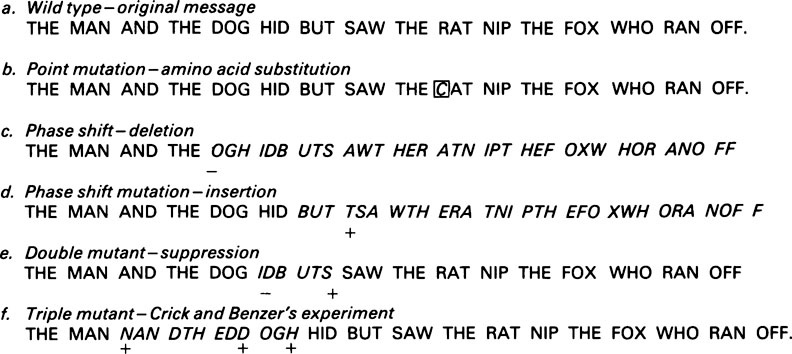Mutations, evolution and inherited disease
Publisher Summary
Genetic differences within a species arise as a result of random mutations that, apart from being the basis of individuality, provide new characteristics that can either be maintained or eliminated as a result of natural selection. Mutations are changes in the nucleotide sequence of DNA and fall into three classes: (1) substitutions, which involve the replacement of a base pair by a different one, (2) deletions, which involve the loss of one or more base pairs, and (3) insertions, which involve the acquisition of one or more base pairs. The substitution of one base pair for another is the most common type of mutation. Causes of mutation in DNA include rare tautomerization of bases to form base pairs, imprecise replication, and proofreading by DNA polymerase, natural background radiation, damage by strong ultraviolet light, and exposure to chemical mutagens. Among the chemical mutagens are base analogues such as 5-bromouracil and 2-aminopurine, which become incorporated into DNA in place of the normal bases and lead to errors in base pairing; acridine dyes such as proflavin and Acridine Orange, which intercalate or bind between adjacent base pairs, thereby distorting the DNA helix and leading to the insertion or deletion of one or more base pairs; and alkylating agents such as the nitrogen mustards and other compounds such as hydroxylamine and nitrous acid, which chemically modify specific bases.
Mutations and mutagens
Mutations in protein-coding sequences
Point mutations (base substitutions)
Mutations of this type within the protein-coding regions of genes can have a variety of effects on the resulting protein (Figure 22.1).
(i) Since the genetic code is degenerate and there are alternative codons for most of the amino acids, a base substitution can occur without having any effect on the structure of the protein synthesized. For example, UUU and UUC are both codons for phenylalanine, so a mutation which converts one to the other is known as a silent mutation.
(ii) If, on the other hand, the codon UUU is converted to either UUA or UUG, there will be an amino acid replacement since UUA and UUG code for leucine instead of phenylalanine, and at this one position in the protein chain the mutant will differ from the normal or wild type. In many instances single amino acid replacements, particularly if the substitutions occur between similar types of amino acid, e.g. both neutral or both acidic, may have little or no effect on the functional efficiency of the protein (Figure 22·1b). Occasionally, however, even a single amino acid replacement may have a profound effect, especially if it involves an active site residue or if it causes a gross change in protein tertiary structure, as for example in sickle cell haemoglobin, HbS.
(iii) If the mutation causes the codon for a particular amino acid, e.g. UCA (serine), to be replaced by a chain termination codon (UAA or UGA), then a truncated protein will be produced. Mutations of this type, unless they occur very close to the C-terminus of the protein, will usually result in complete or severe loss of protein function.
(iv) Conversely, if a chain termination codon is converted into one coding for an amino acid, e.g. UGA to AGA, a larger protein will be synthesized, its length being determined by the distance to the next in-phase termination codon.
Phase-shift mutations (insertions and deletions)
Phase-shift or frame-shift mutations arise from the insertion or deletion of one or more base pairs into the protein-coding region of a gene. If, for example, as a result of a deletion within a gene, an mRNA molecule lacks a base at some point, the reading of all subsequent triplet codons will be out of phase and hence very different; the addition of a single base will have a similar effect (Figure 22·1c and d). Thus, while point mutations may cause only a slight, but possibly significant, alteration in the sequence of a protein, insertions and deletions are likely to result in products with long stretches of completely different amino acid sequence. However, the deleterious effect of a single base addition may be partly overcome or suppressed by a second mutation involving the deletion of a single base close to the site of the first mutation; only the region between the two mutations will now differ from the wild-type protein sequence. A highly significant finding was that if the phage carried either 3(+) or 3(−) mutations in close proximity it hardly differed from the wild type (Figure 22.1f). In these cases the equivalent of a whole new codon had been added to or subtracted from the DNA so that one amino acid was either introduced into, or eliminated from, the protein. Only in the short stretch of DNA separating the first and third mutation was the message garbled. This work gave proof to the suggestion, which was originally based on theoretical considerations, that the genetic code is a triplet code.
Sequence divergence
One way of facilitating sequence divergence is by means of gene duplication. This falls into three types. (i) If two identical copies of a gene exist, then one can mutate at a higher rate without depriving the organism of a functional protein as supplied by the other gene copy. In this way the faster mutating copy may eventually diverge to encode a new function. The separation of functions between embryonic and adult globin genes (page 371
Stay updated, free dental videos. Join our Telegram channel

VIDEdental - Online dental courses



